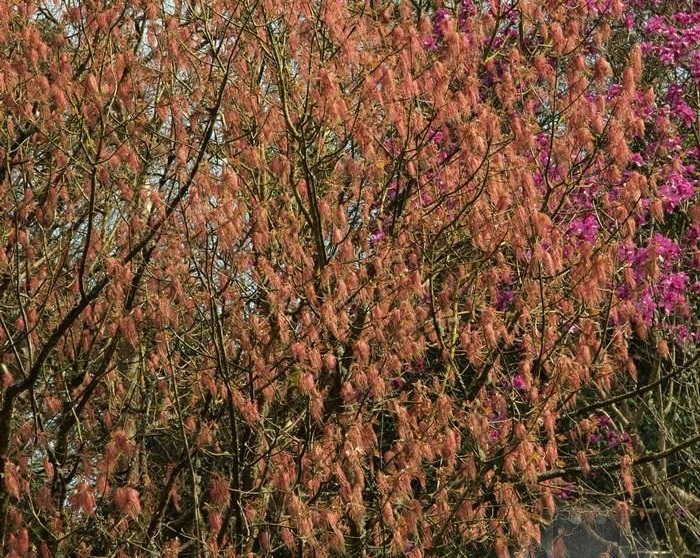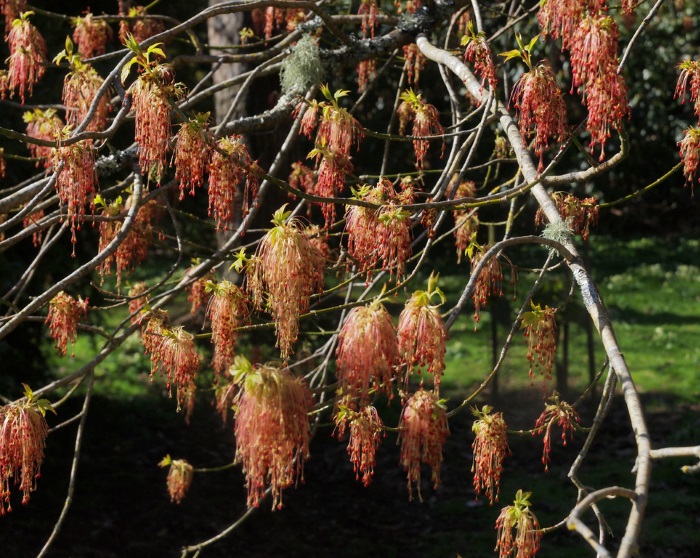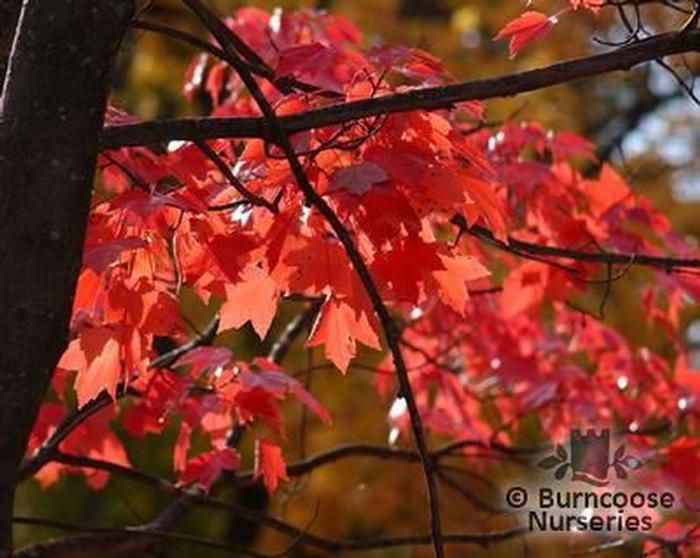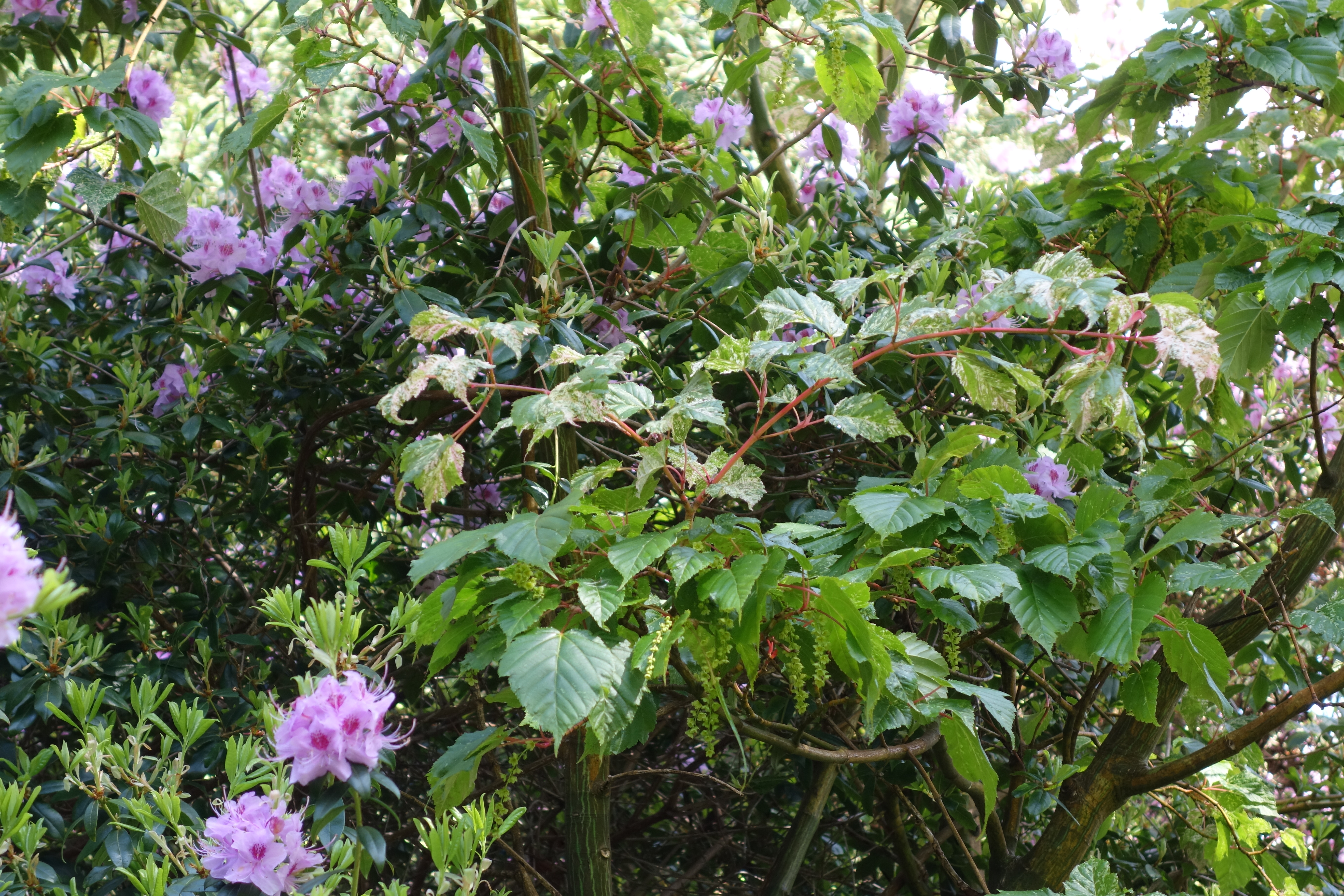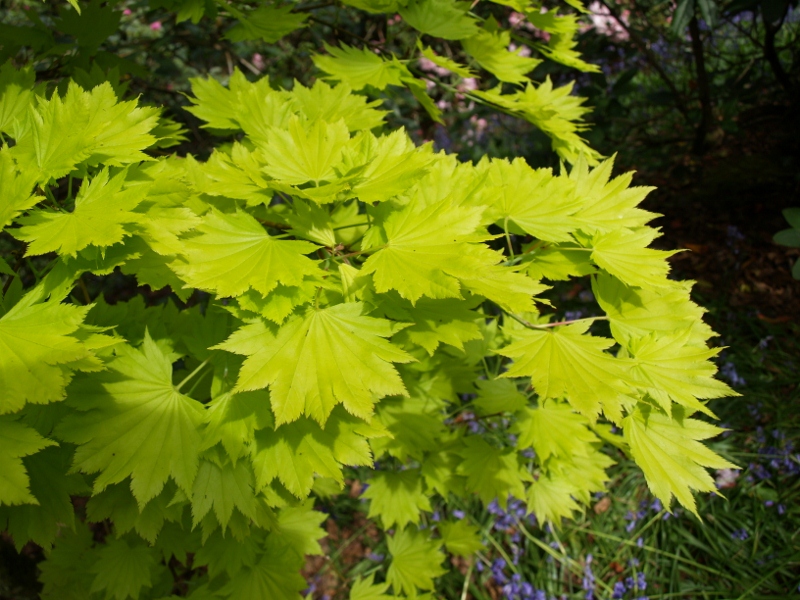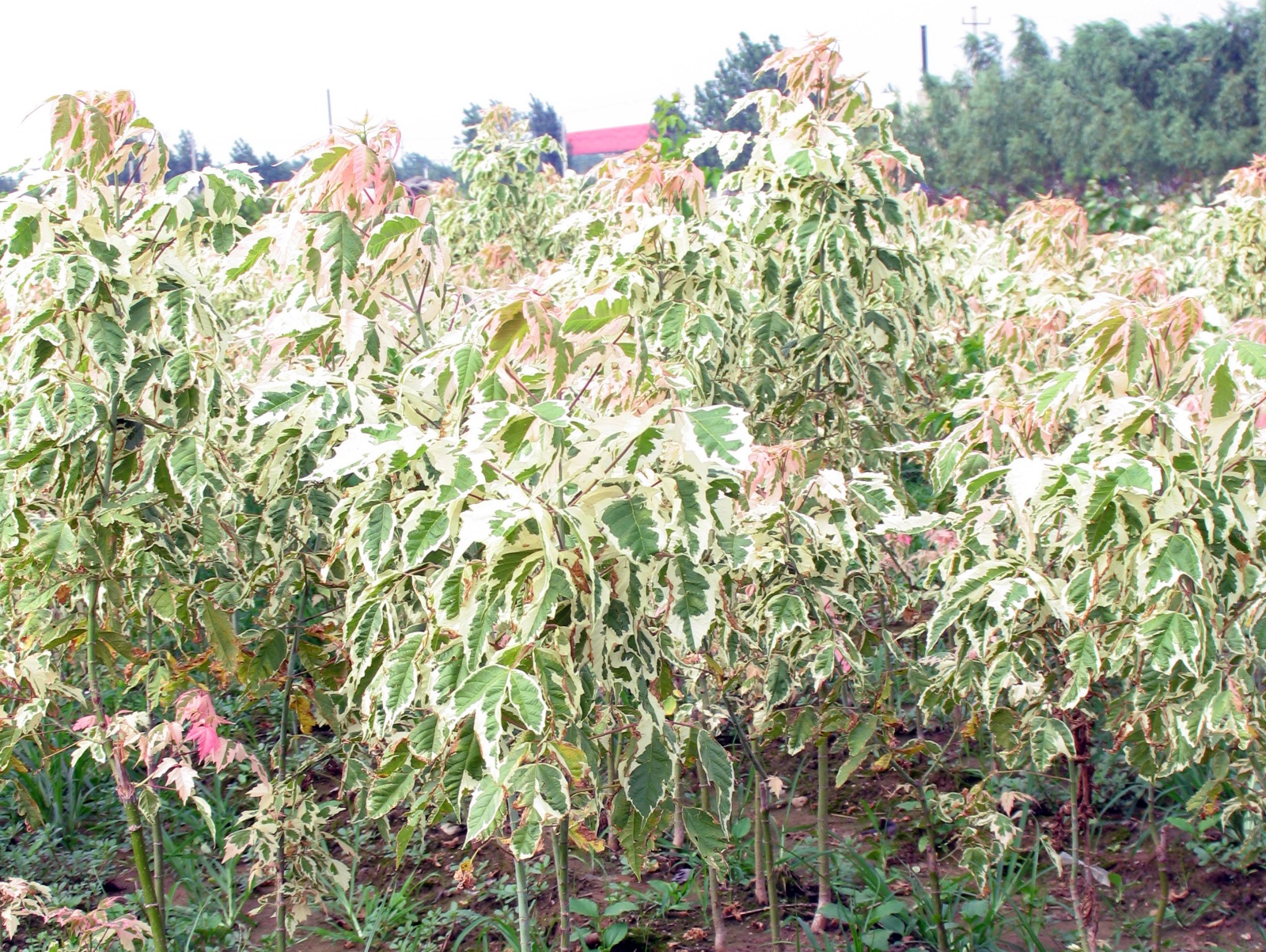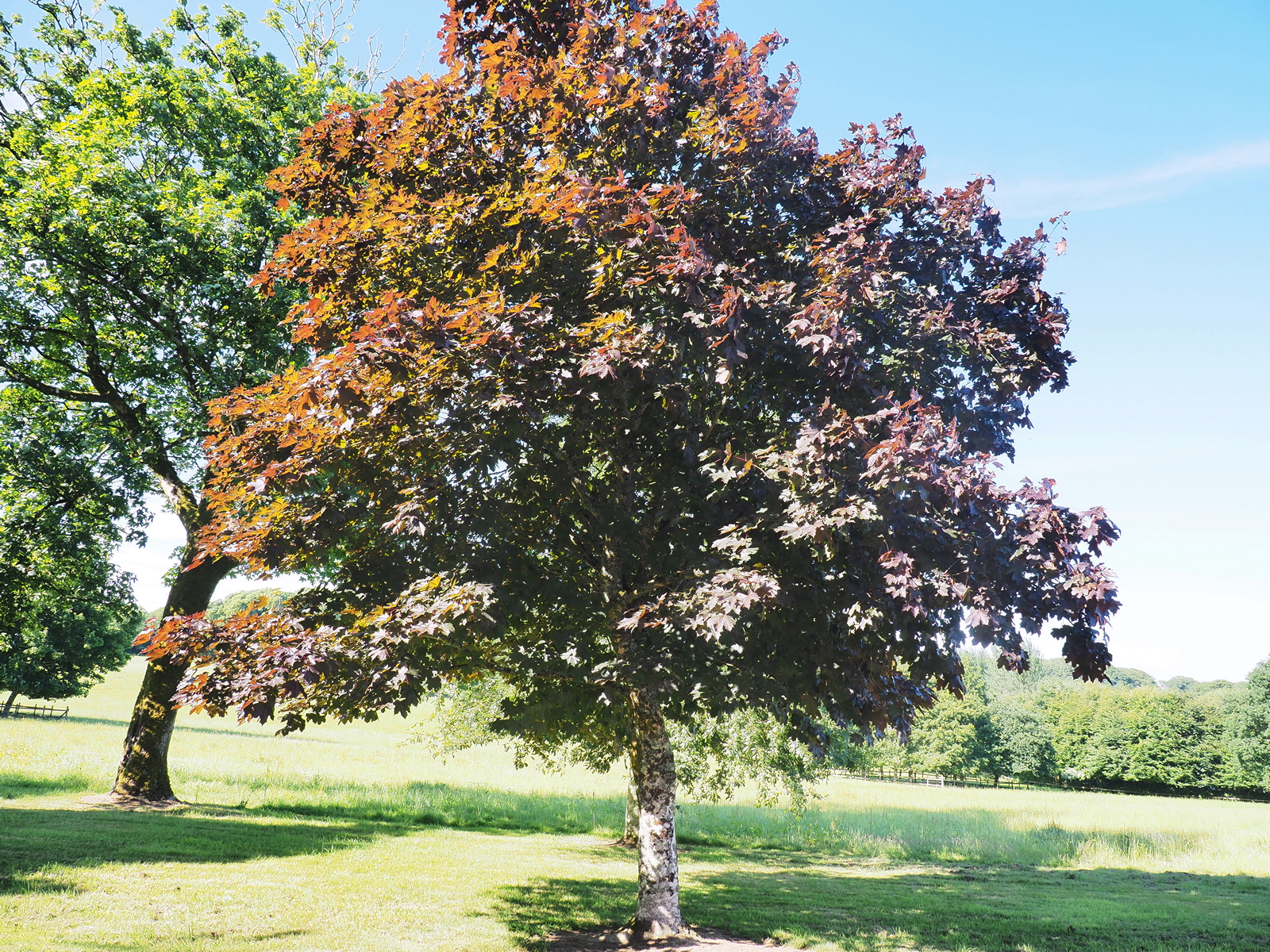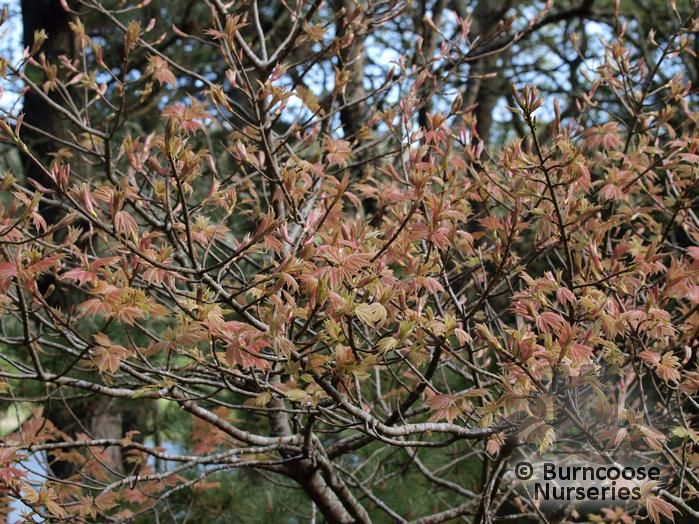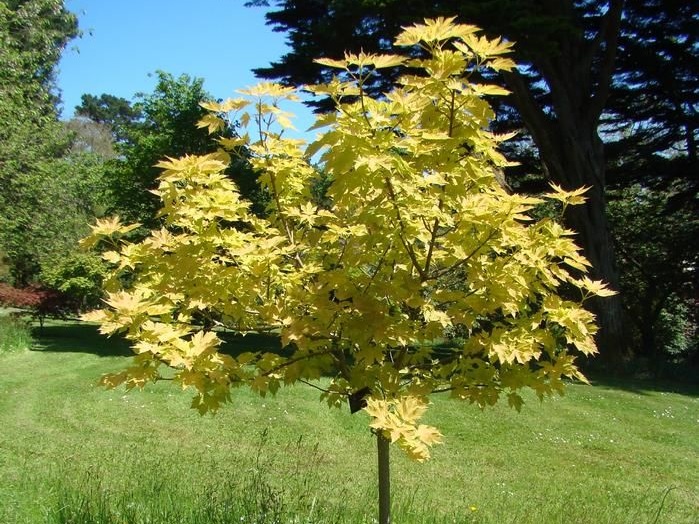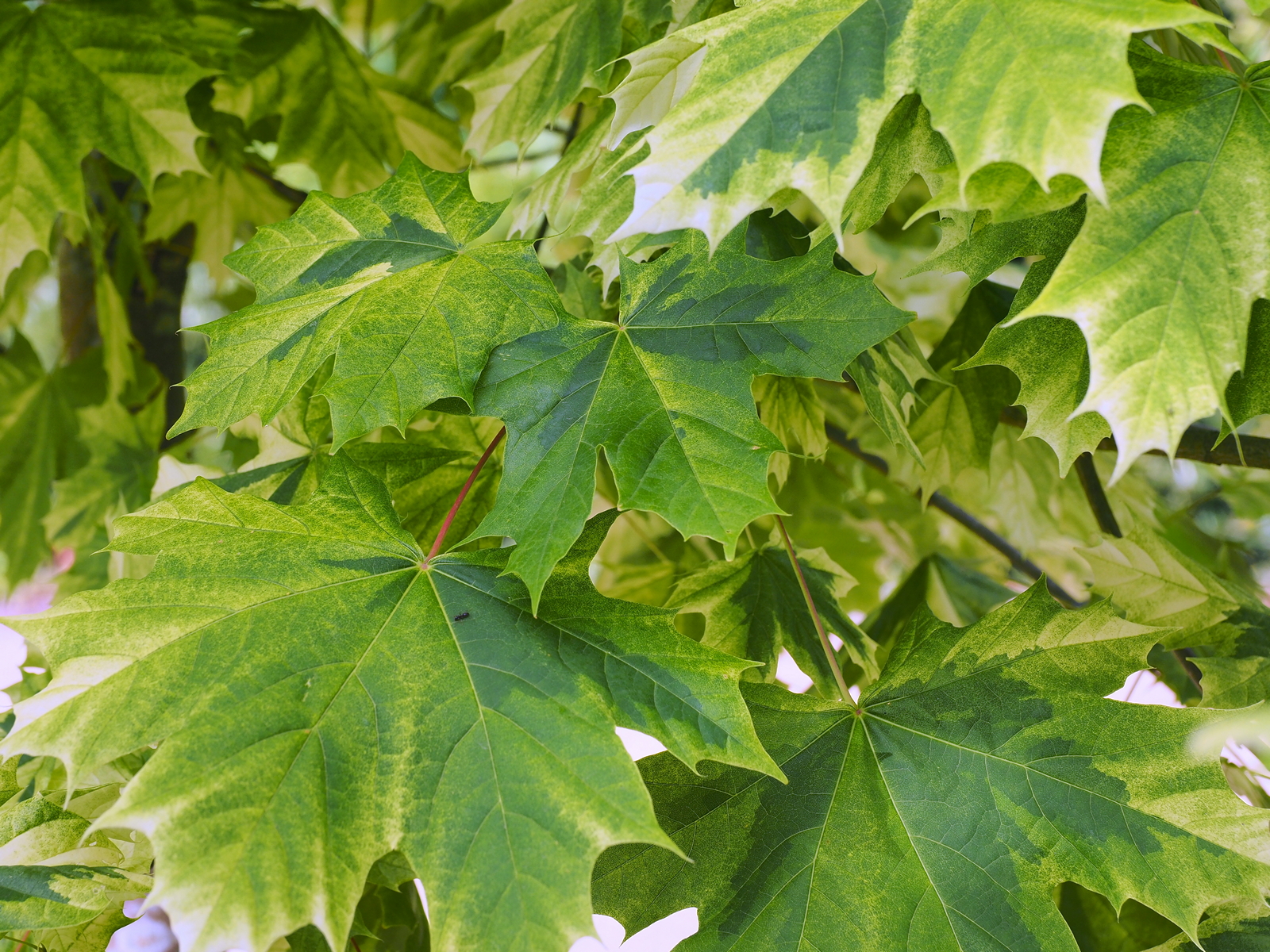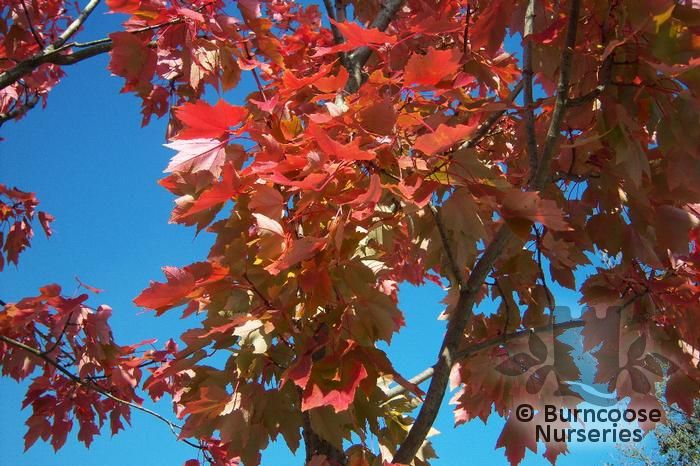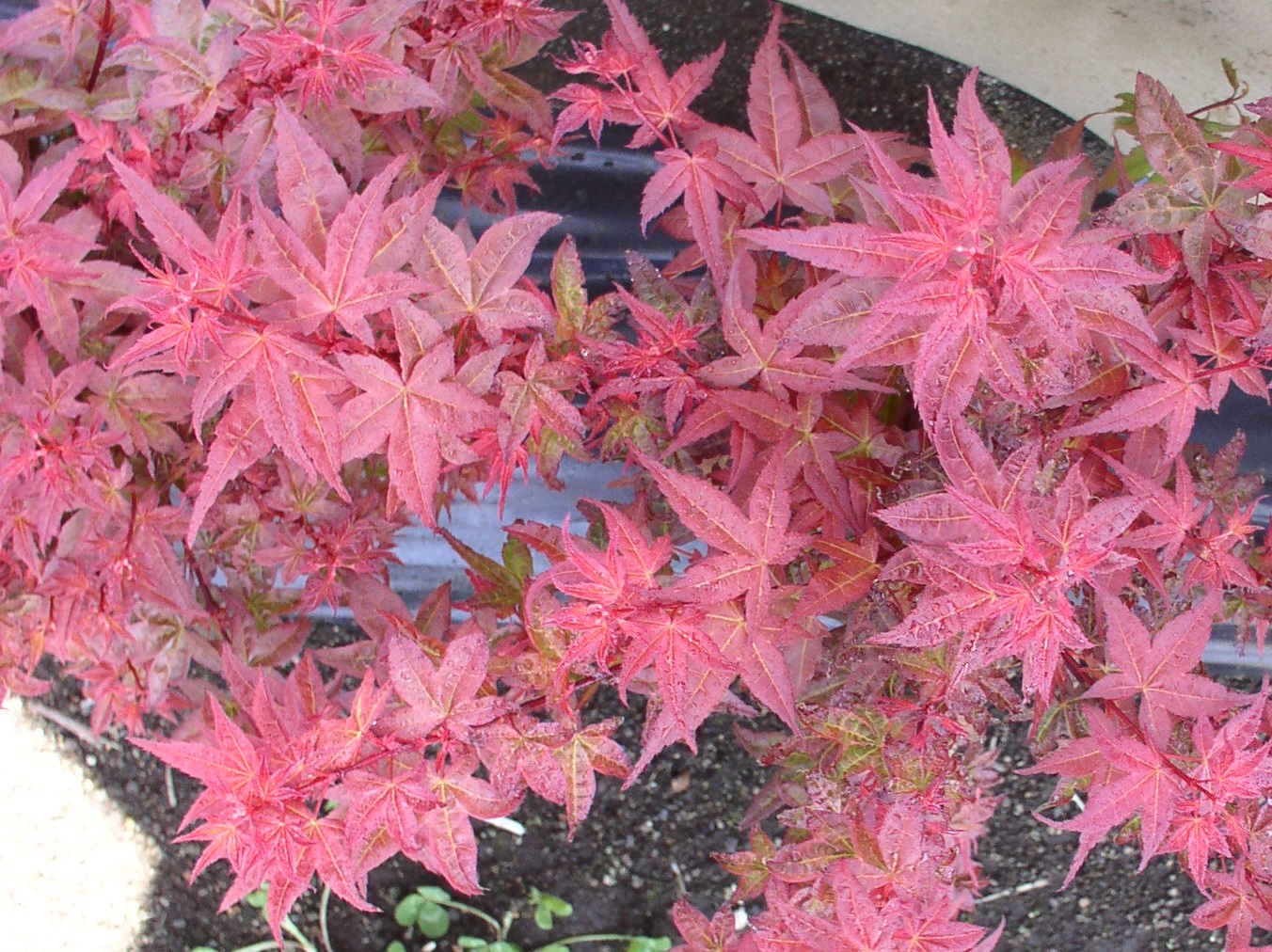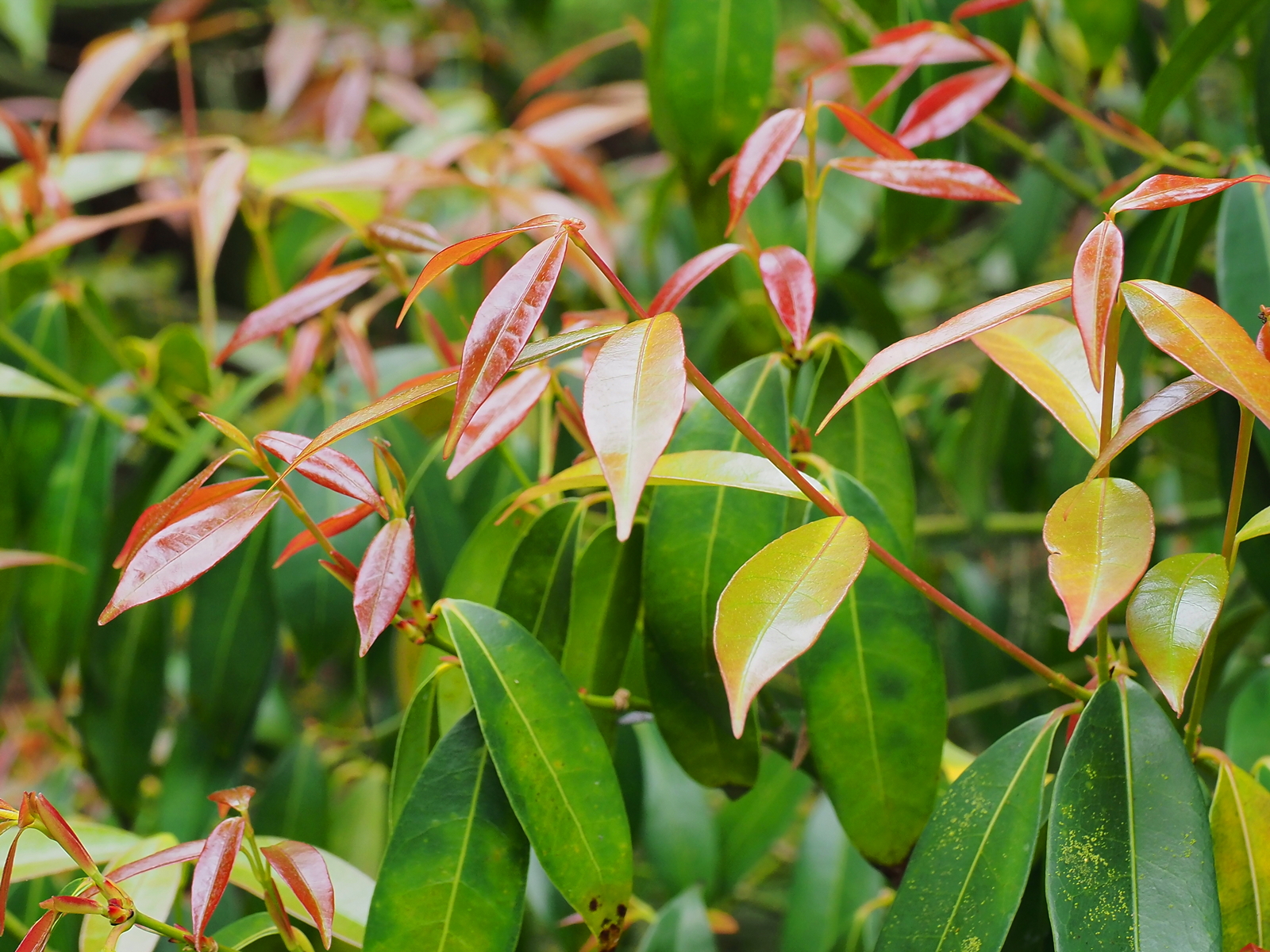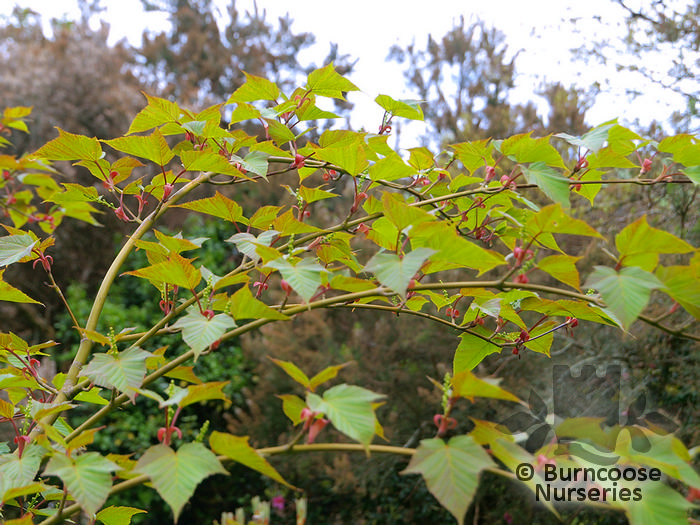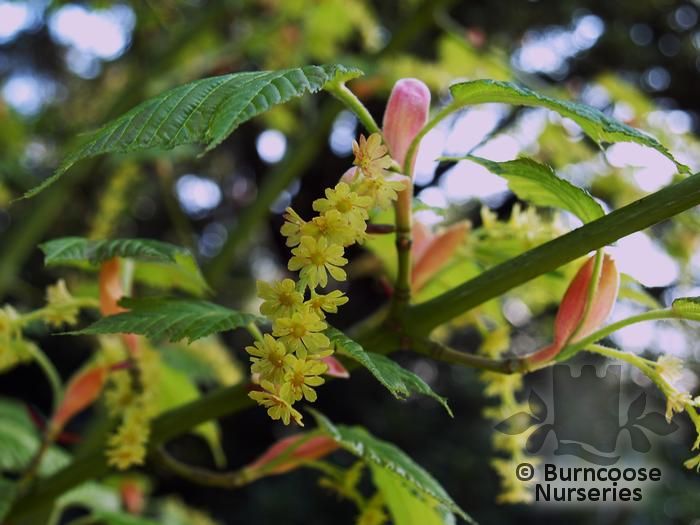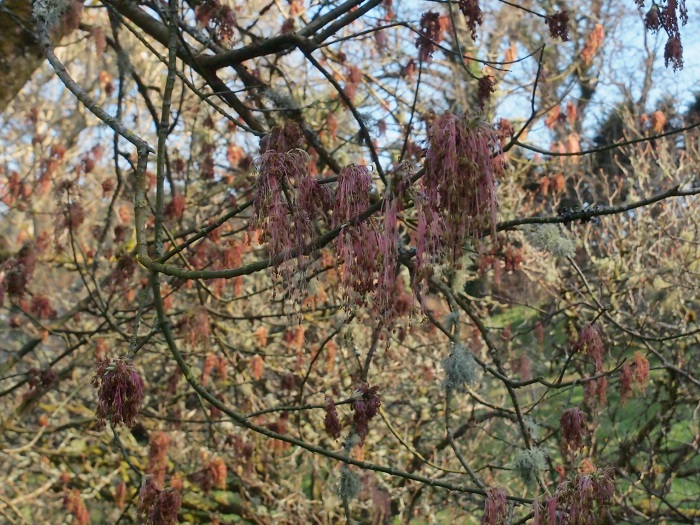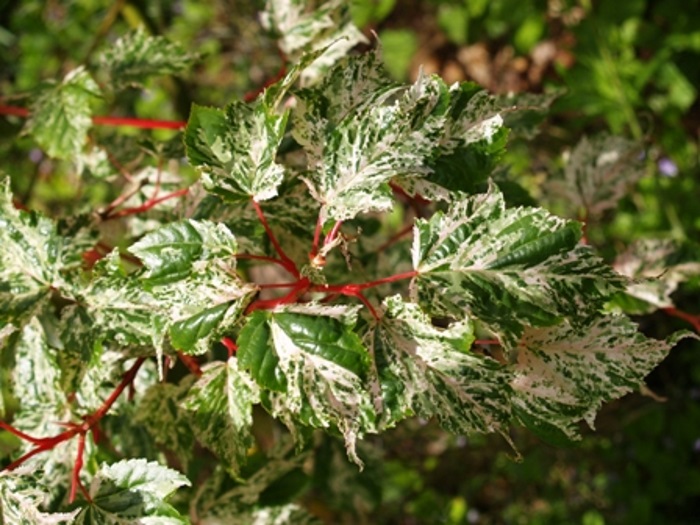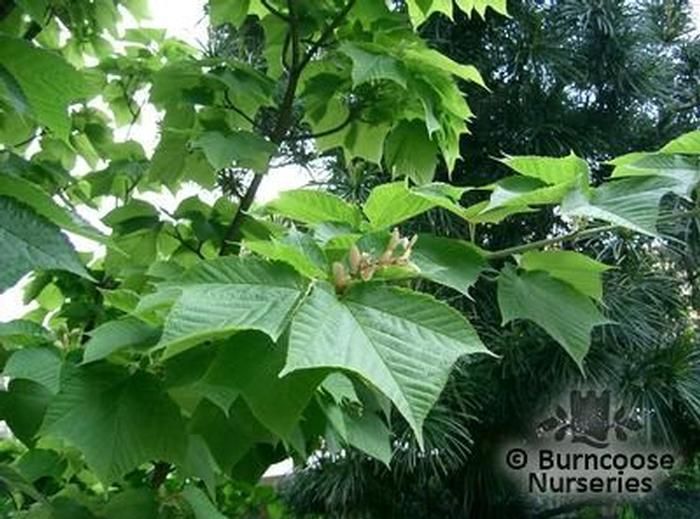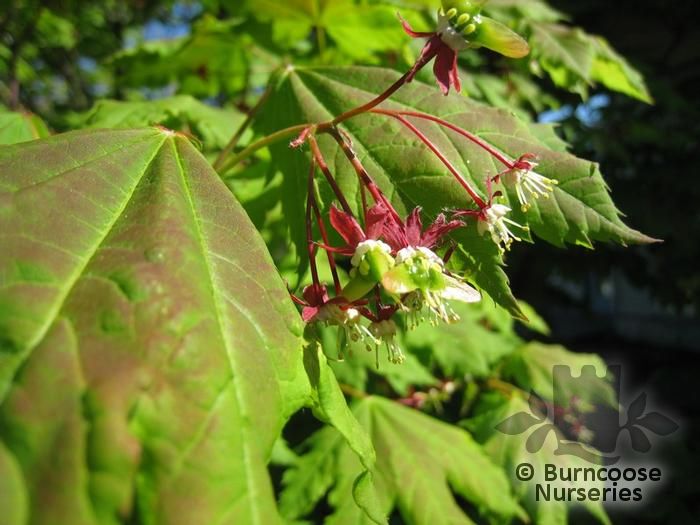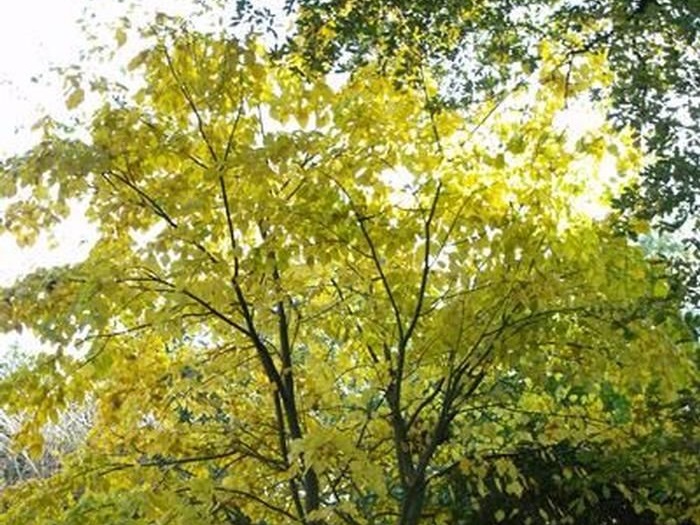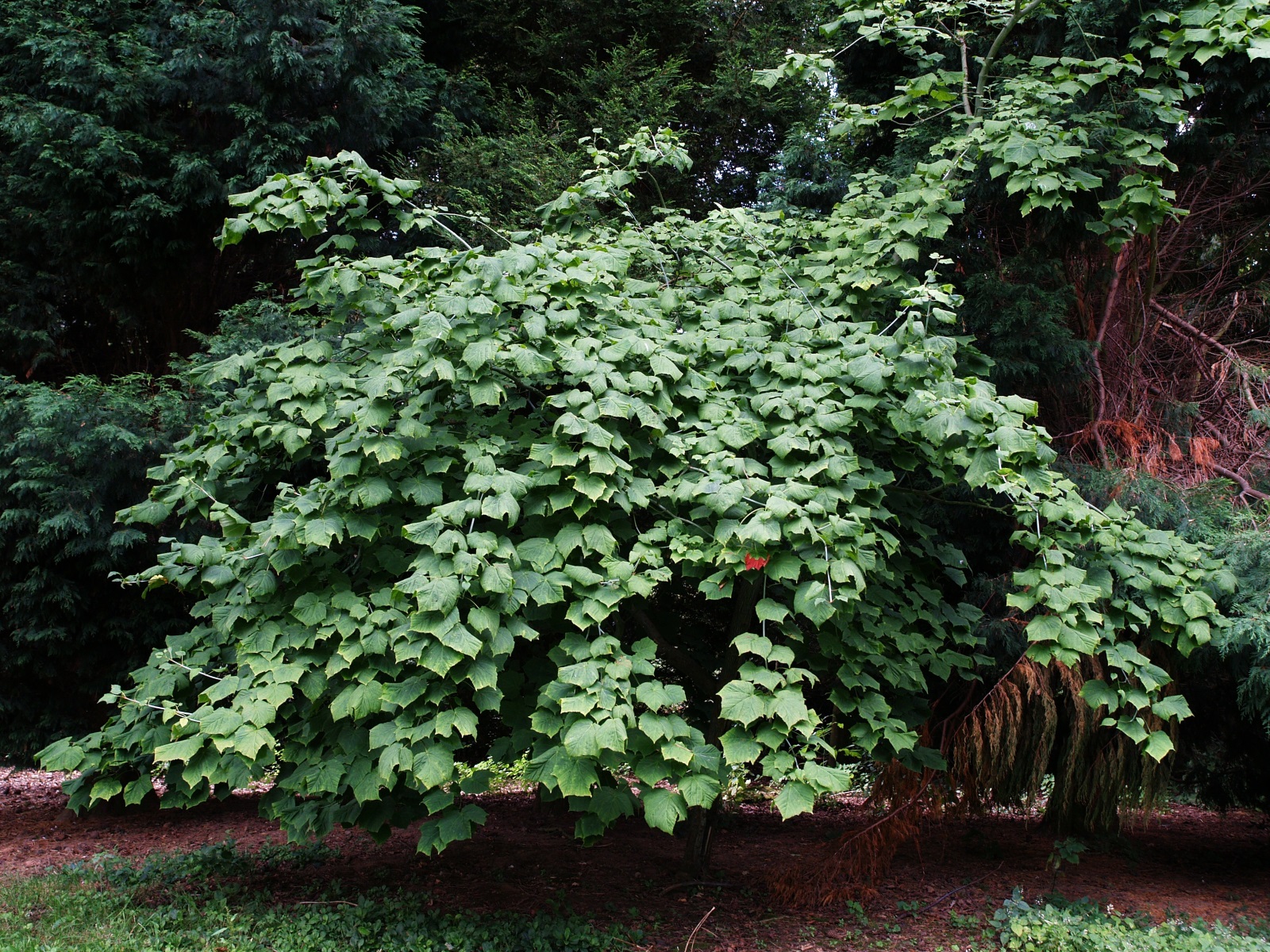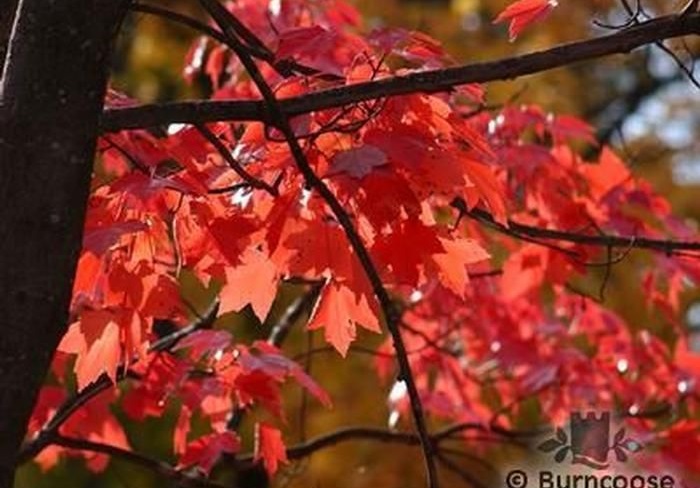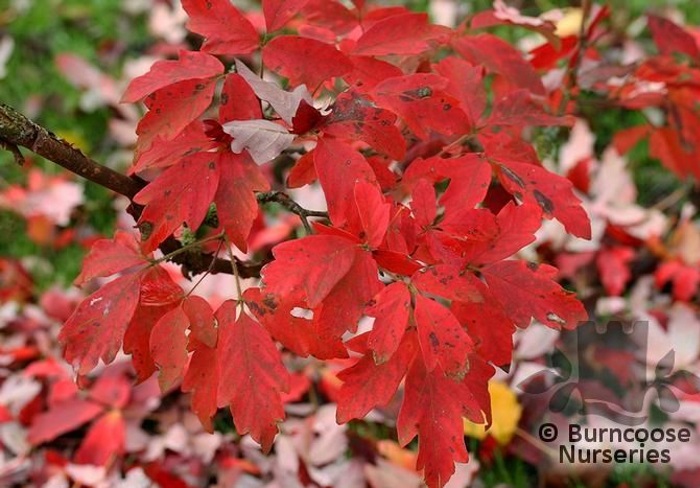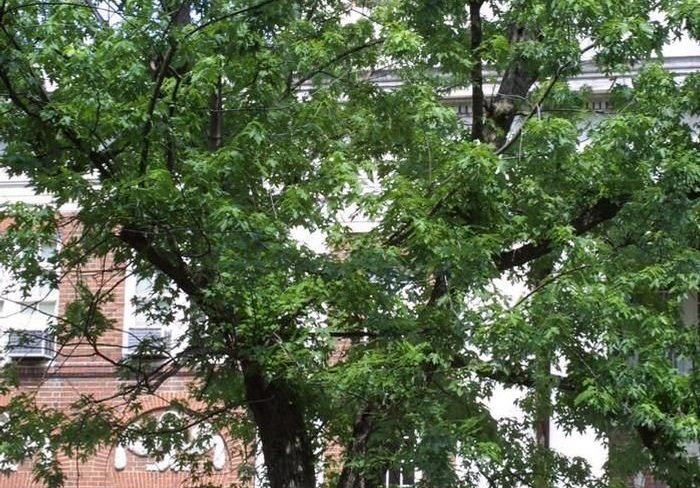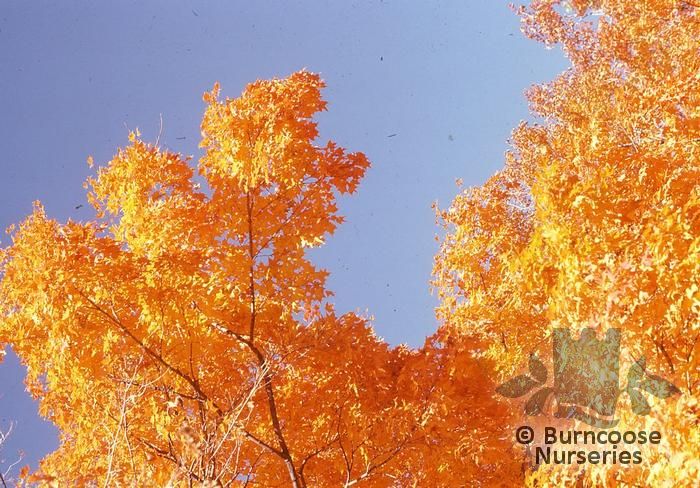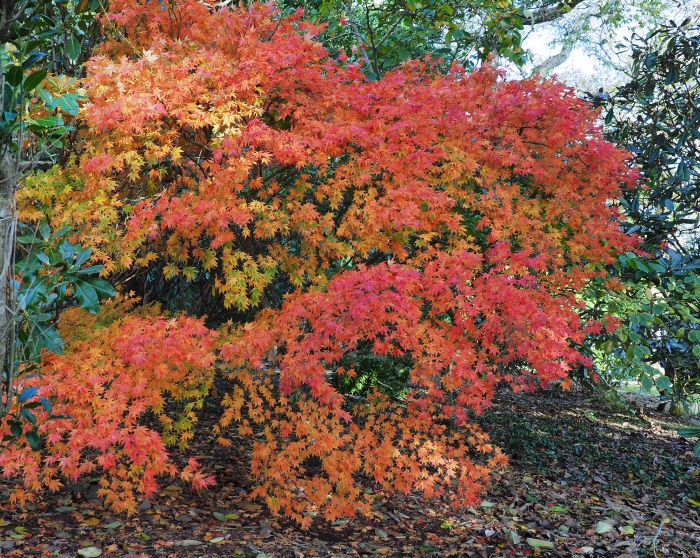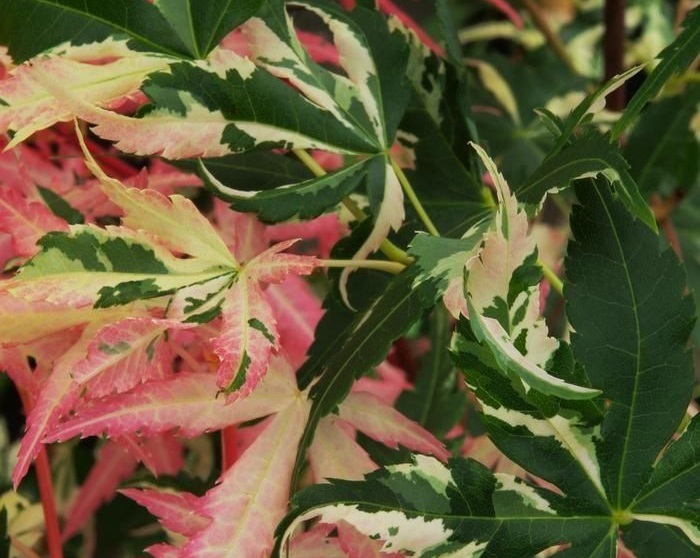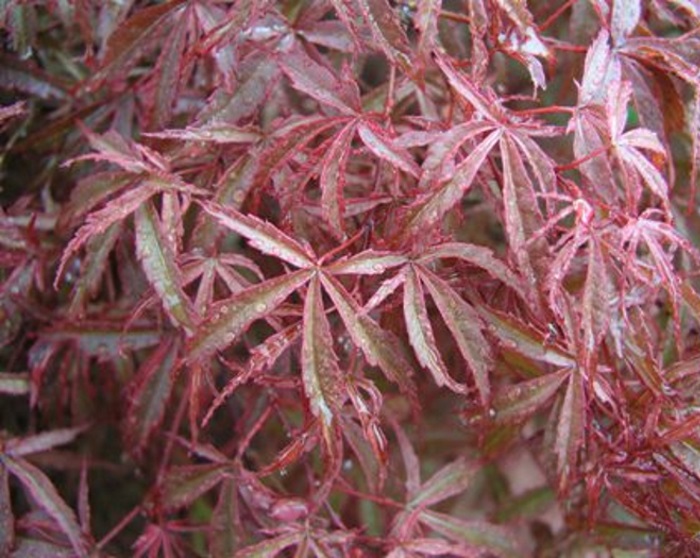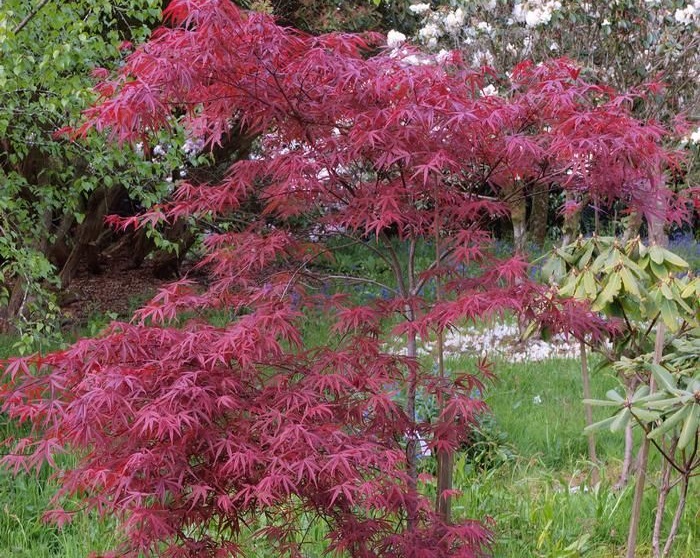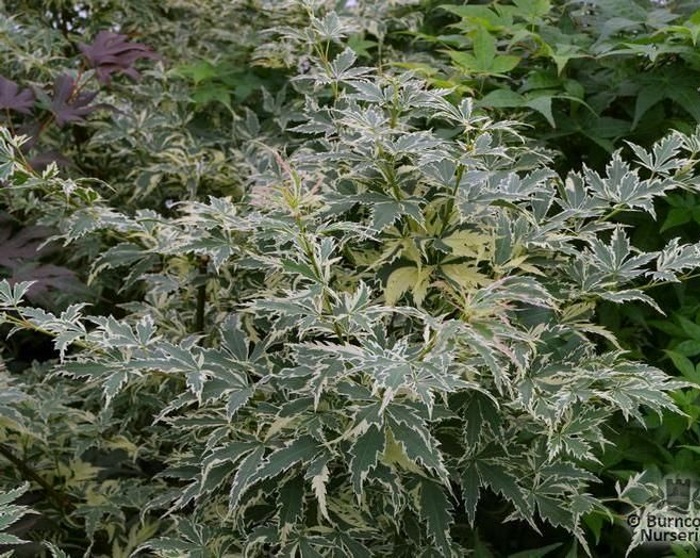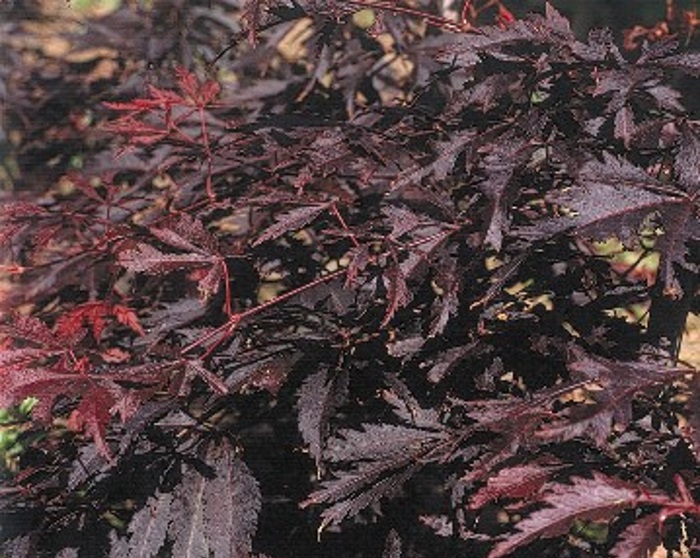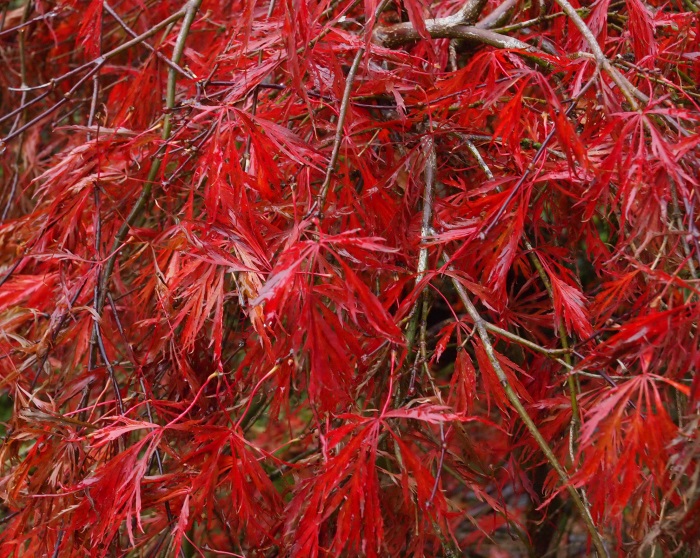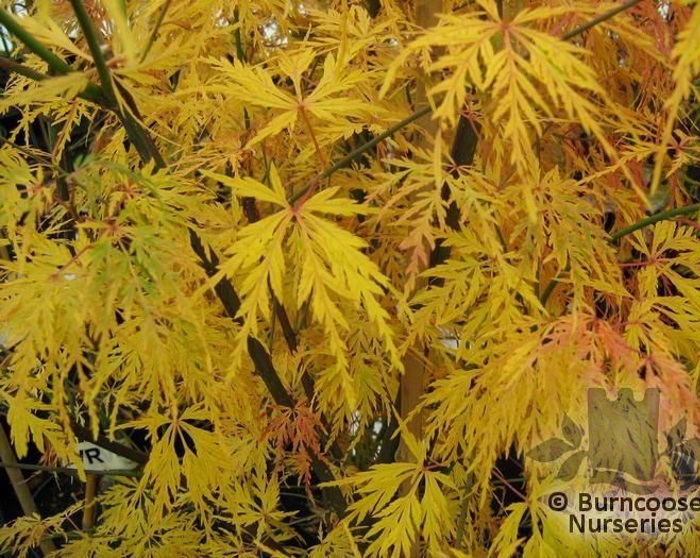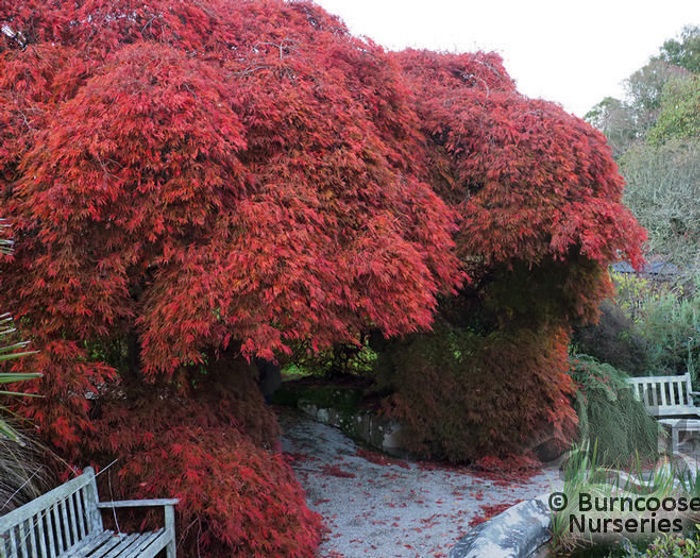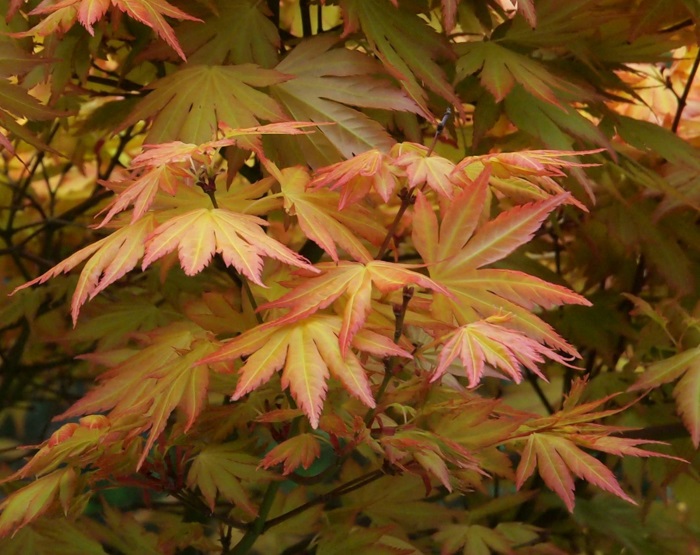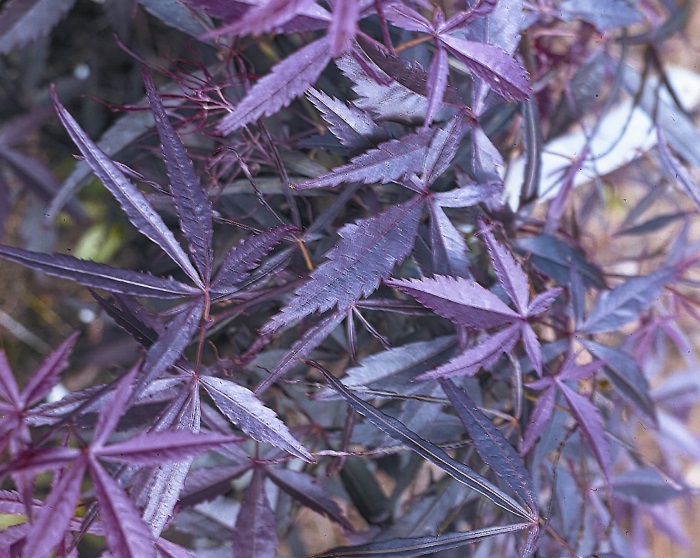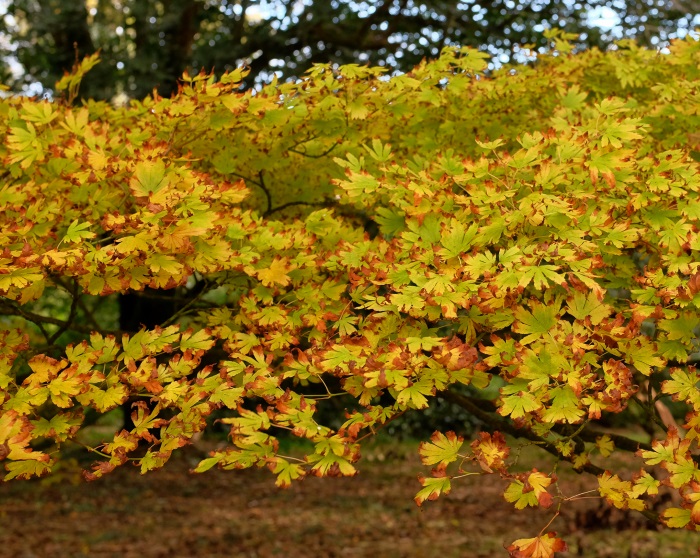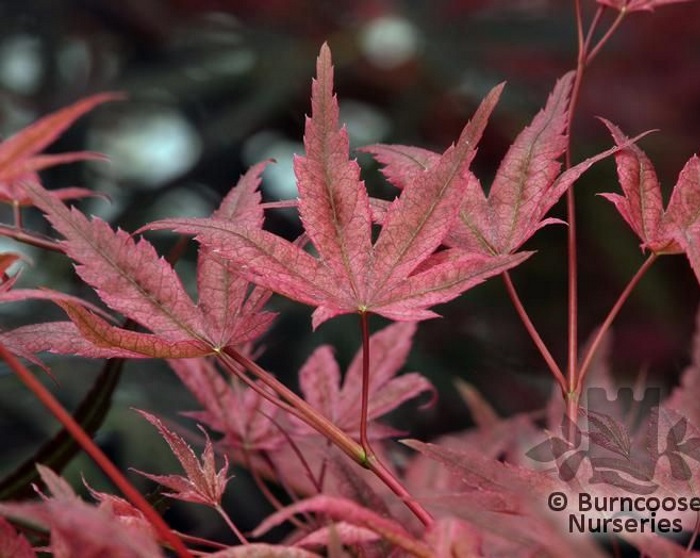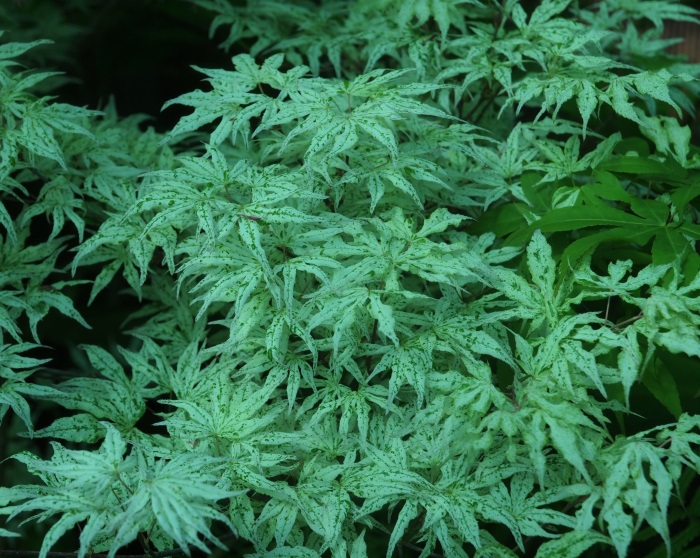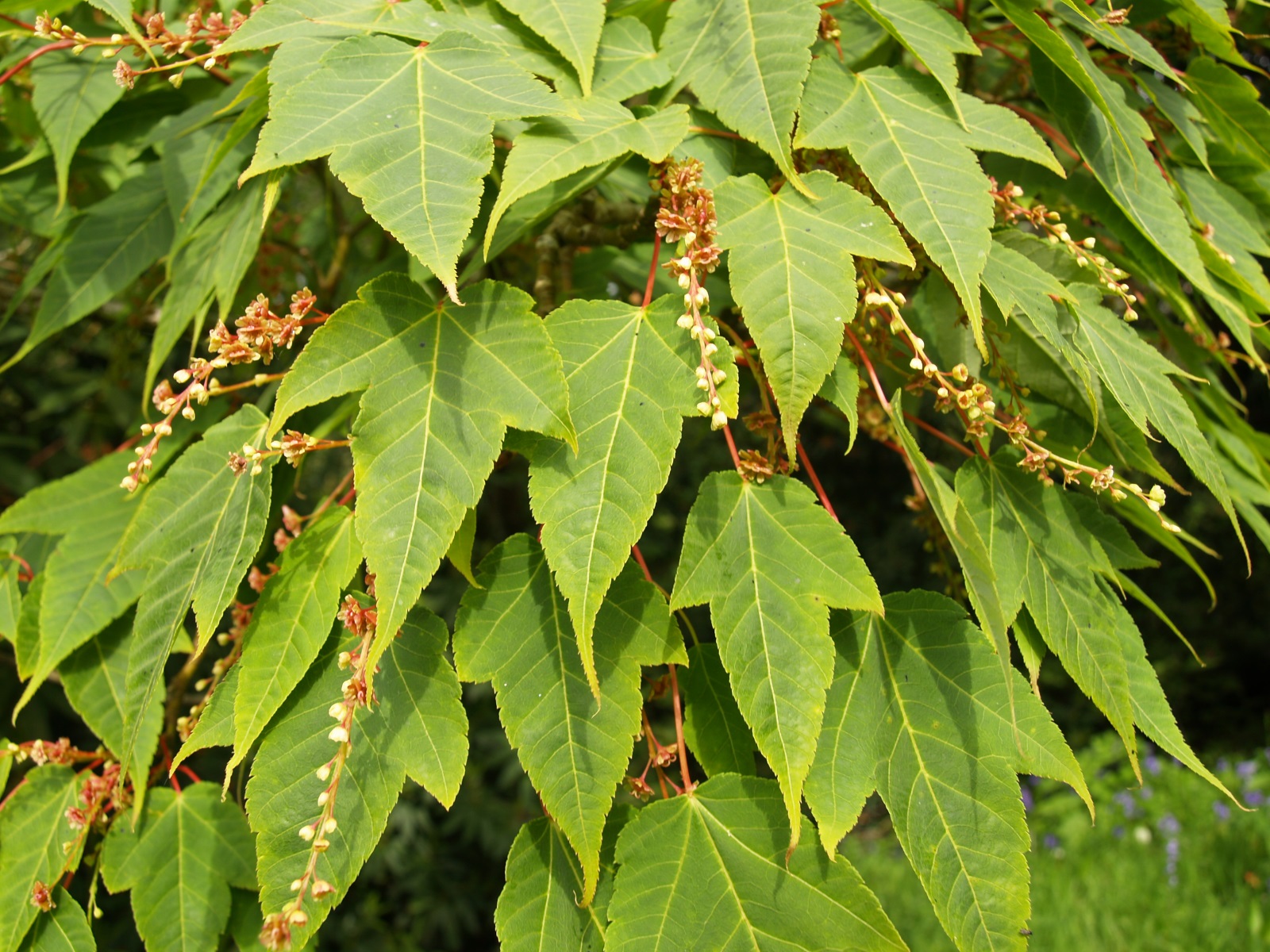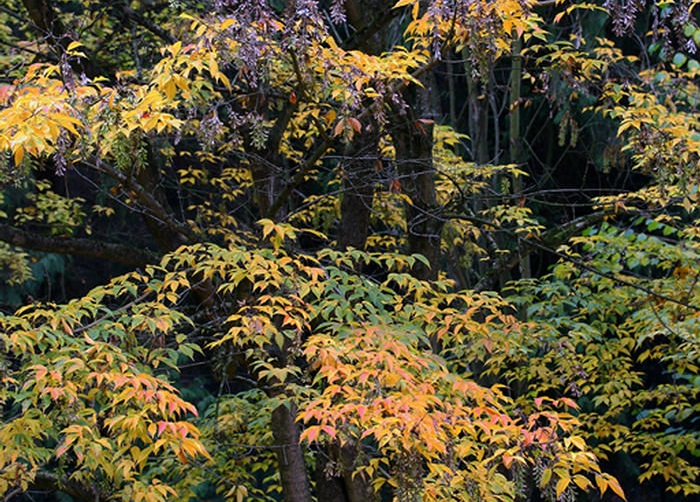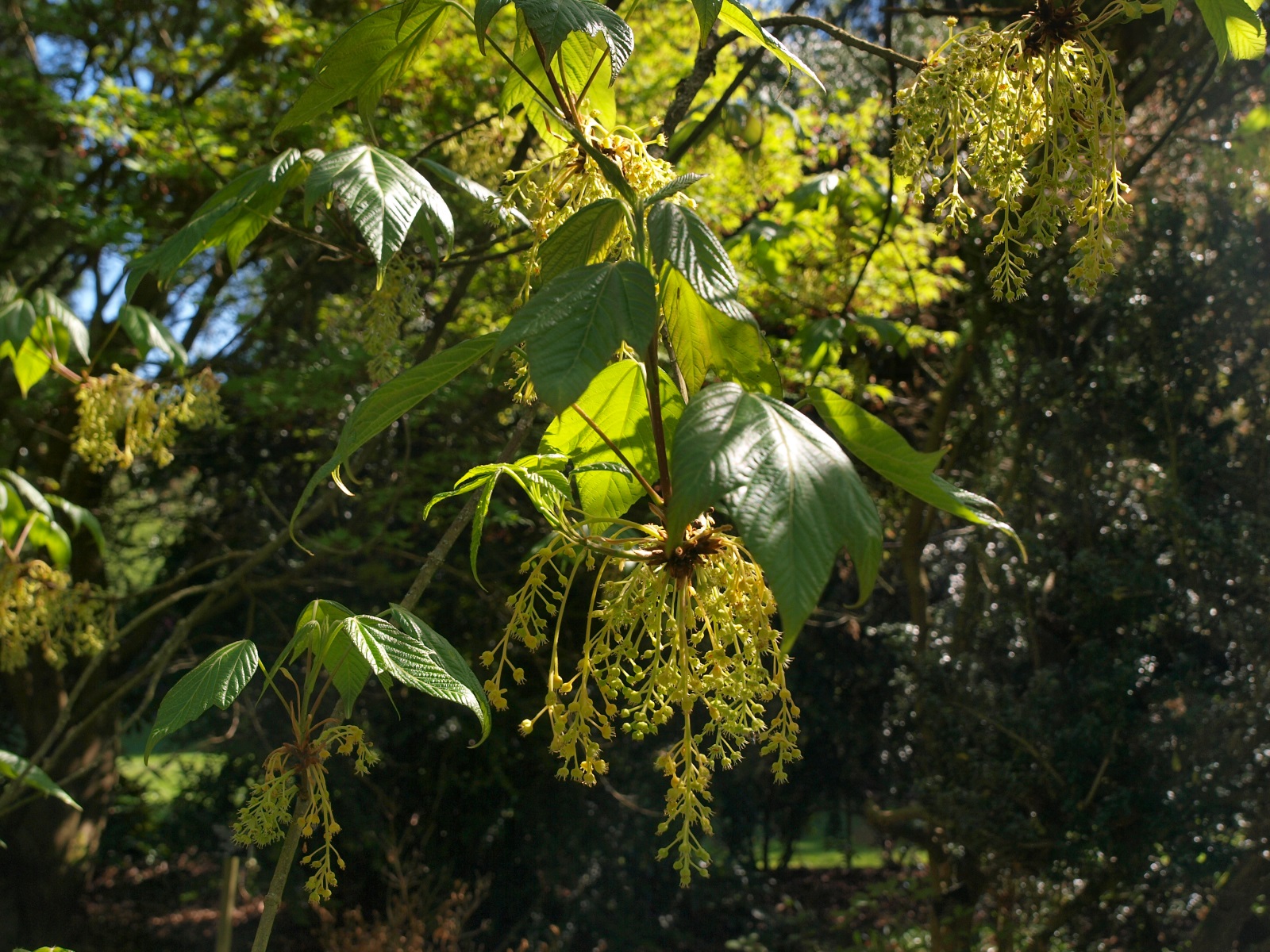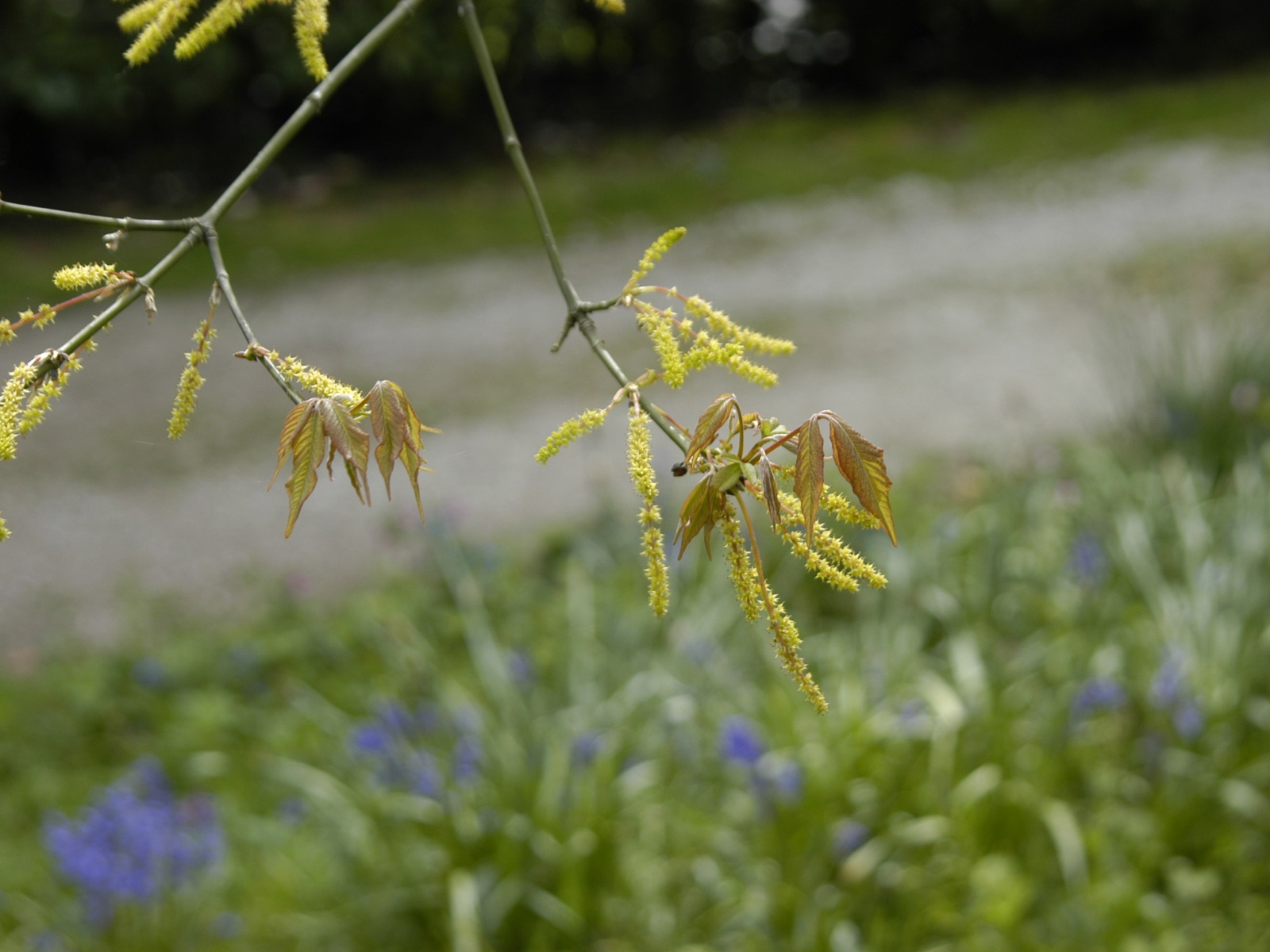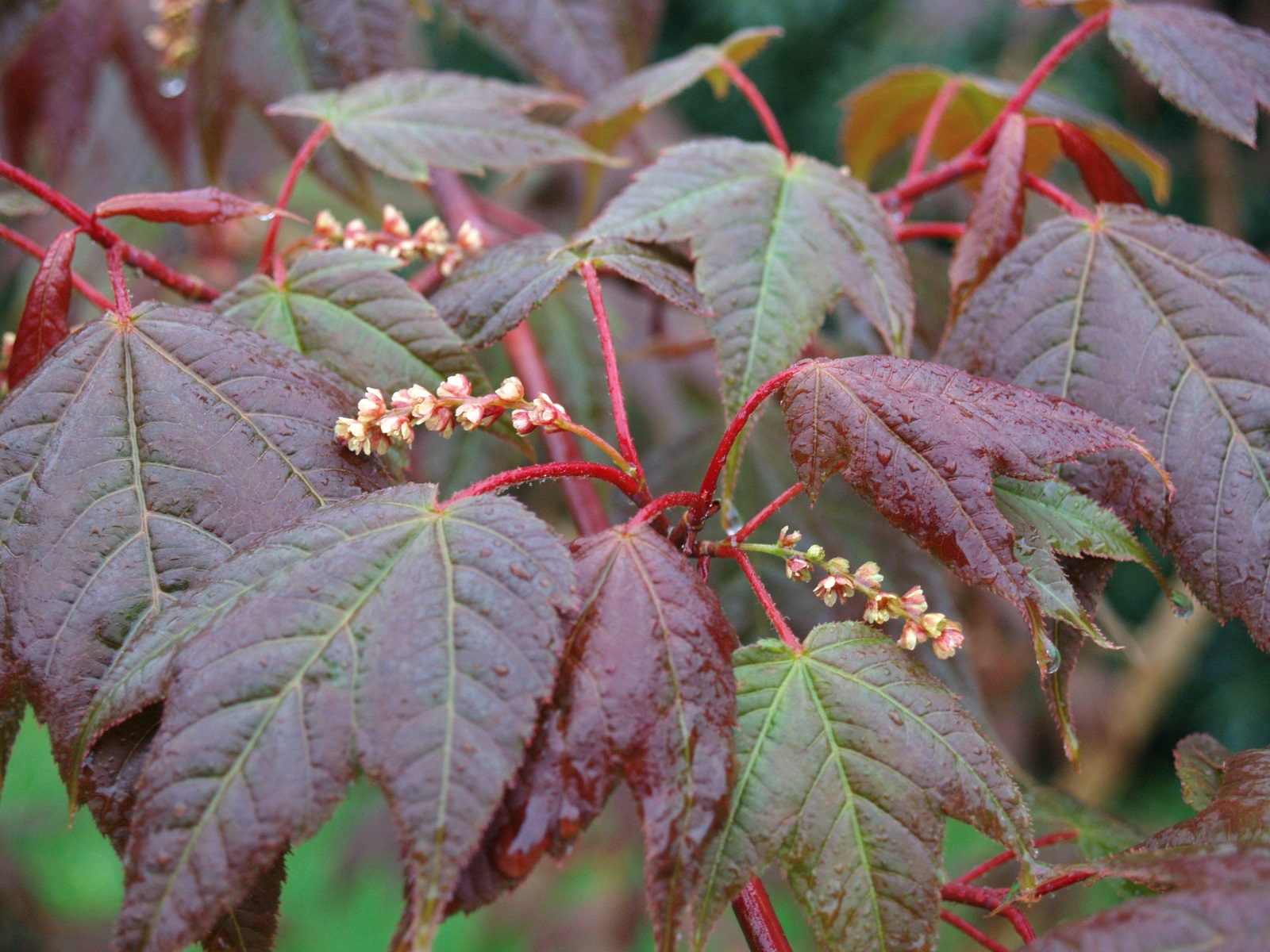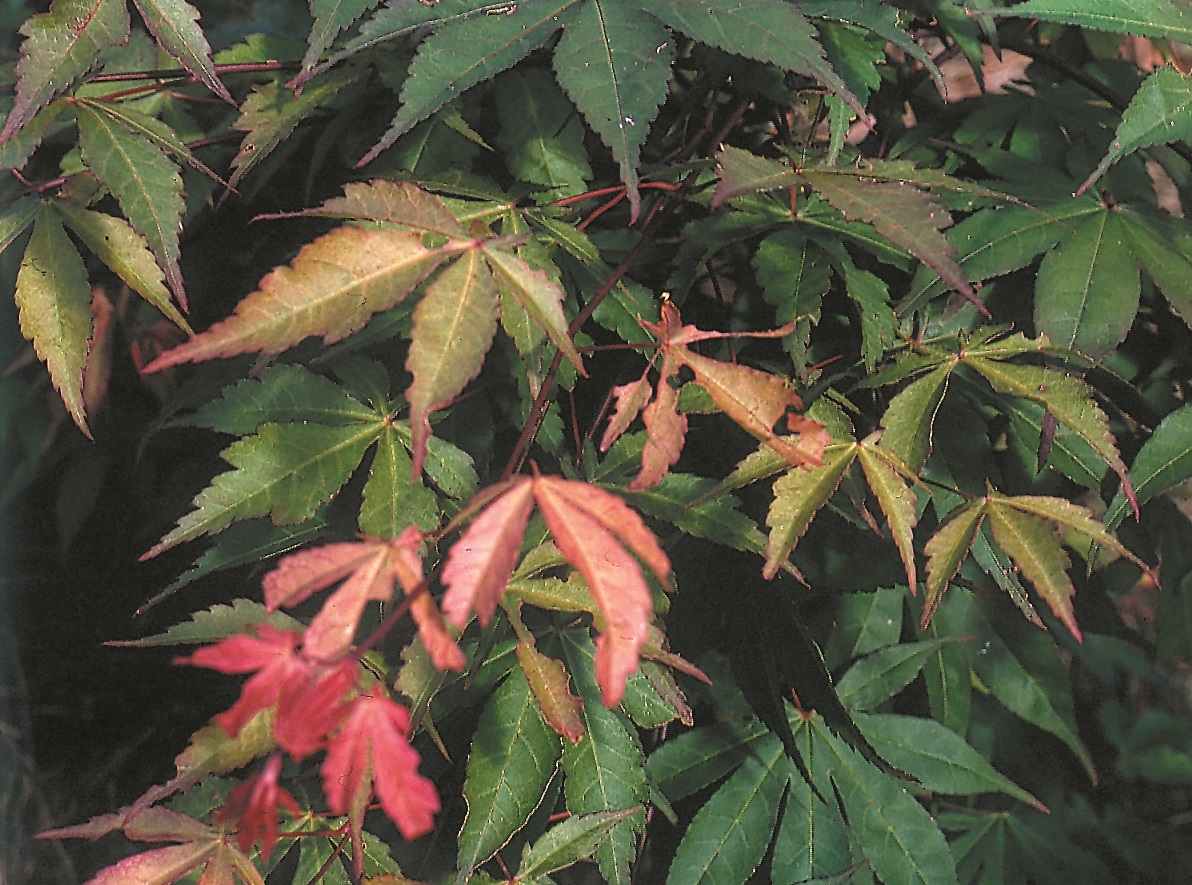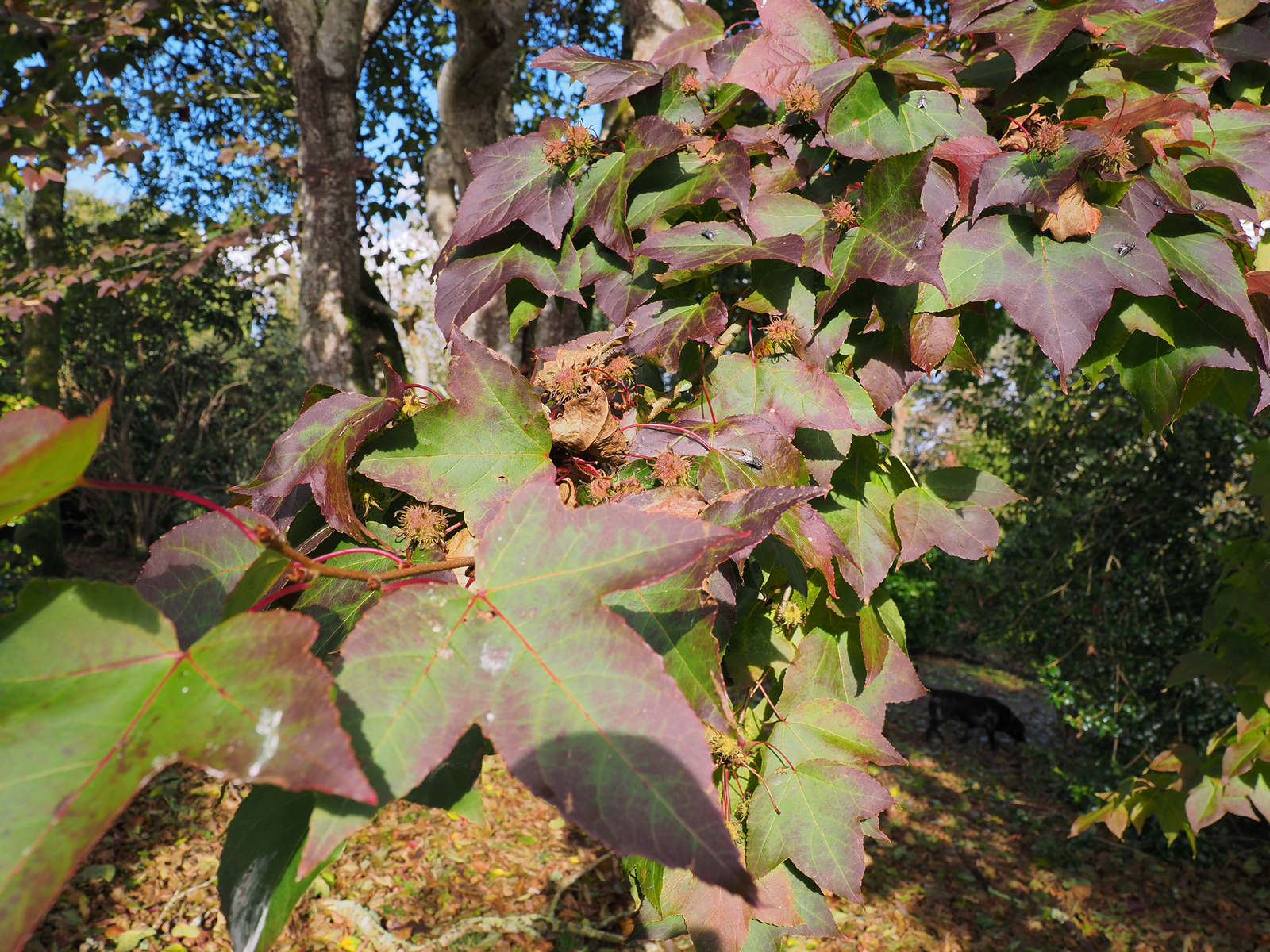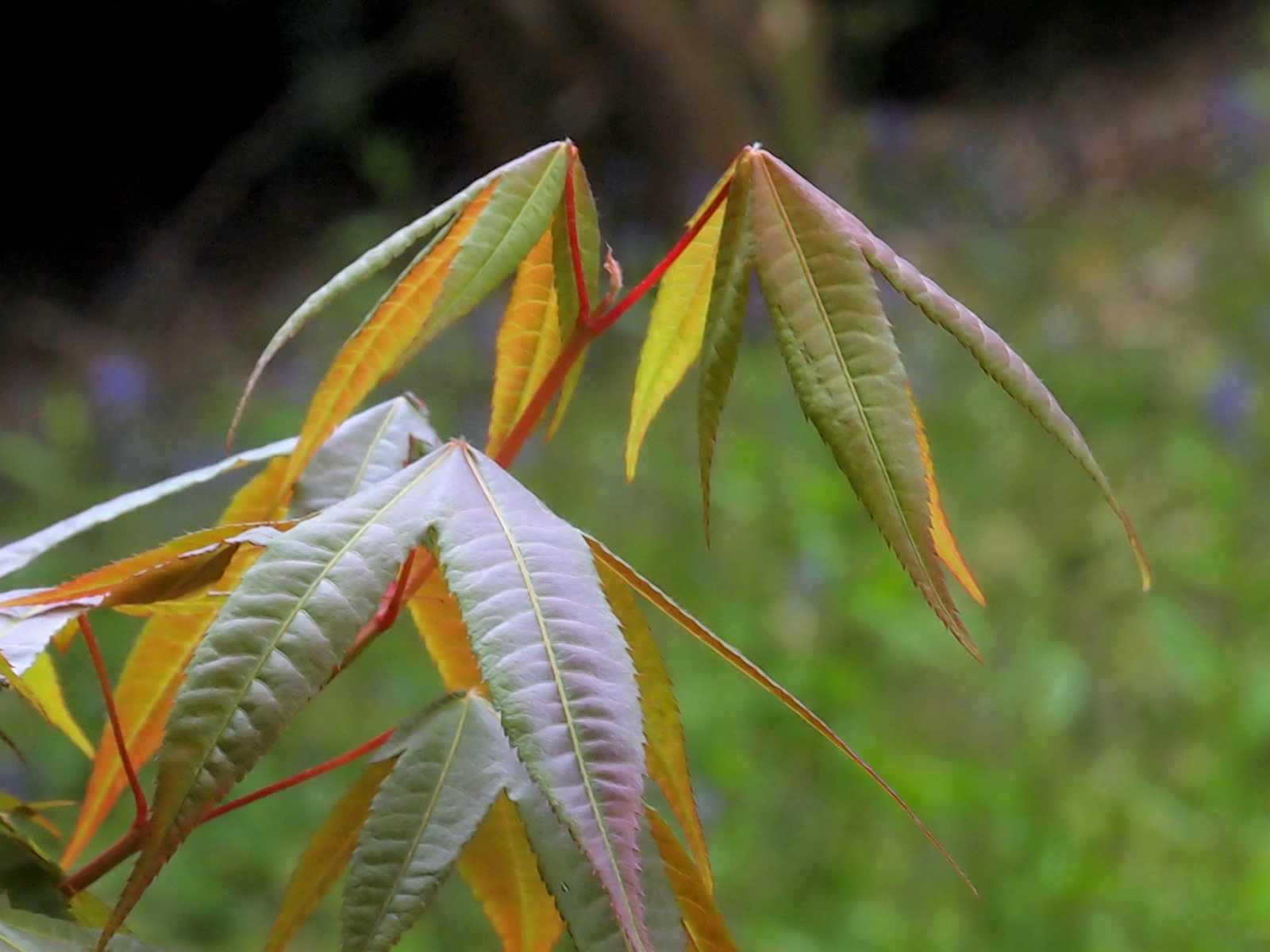Maples at Caerhays
RHS Lecture
1. ALL YEAR ROUND INTEREST FROM MAPLES AT CAERHAYS
The word acer derives from the word ‘ac’ meaning ‘sharp’ or ‘pungent’ and its association with the word acer from its sharp leaves. The word acer was officially assigned to the genus by Linnaeus in his famous ‘Species Plantarium’ of 1753 which lists 9 species of acer.
Another interpretation of the derivation of the word acer suggests that it is derived from the word ‘acris’ because of the very great hardness of the wood. The Romans certainly used acer wood for making writing tables on account of its hardness and firmness. Both Ovid and Pliny refer to ‘acerous’ wood.
You may think of acers as being at home in the temperate climates of North America, Europe and Asia but they also enter the tropics in S.E Asia. There are about 150 species in all. A remarkable characteristic of acers is that species live together within each other’s geographic range without hybridising. The best example of this in the UK is Acer pseudoplatanus and Acer platanoides – the sycamore and Norway maple. One of the results of this is that maples tend to be “widely distributed but nowhere abundant”. In the wild populations of maples do not generally grow in isolated thickets but are spread out. In turn this means maples were introduced into cultivation for their many beautiful characteristic:
FLOWERS
BARK
AUTUMN COLOUR
YOUNG FOLIAGE
SEEDS
So we have an enormous topic with a great deal of plant hunting history attached at which I intend to scratch a little to try to whet your appetite for the subject. Inevitably we will concentrate on young foliage and, equally inevitably, the Japanese Acer palmatum varieties are at the forefront of this article as there are now over 250 cultivars or varieties to choose from.
The only maple which is indigenous to the UK is Acer Campestre, the Field Maple, and no other maple species are thought to have arrived in the UK before the 15th Century. It was in Scotland that the first planting of the French native sycamore took place possibly because of the association of Mary, Queen of Scots, with the French. The Norway Maple arrived in Edinburgh in 1603 Acer negundo in 1678 together with Acer rubrum in 1656 from the New World.
2. SPRING COLOUR
The buds and young stems of many maples are a delight in winter and especially as the leaves begin to unfurl in spring to give a rich tapestry of colour. Many maples have bronze or purple young foliage and are adorned with flowers in spring. Here is a small sample of what the visitor to Caerhays may see:-
Acer campestre ‘Carnival’
A. campestre is a native to Europe including the UK and prefers limey soils. It is a neat shaped small tree although you do see it as a roadside hedging plant in some areas such as the Isle of Wight. This is a variegated leafed form which makes an impressive backdrop to a border.
Acer japonicum ‘Aureum’
Very slow growing small bushy tree which has been in cultivation in Japan for at least 200 years. The light green new growth gradually turns yellow as the summer months progress.
Acer negundo ‘Variegatum’ or ‘Flamingo’
Large trees which are a native of North America and especially the Mississippi Valley. The flowers have long flowing tassles. Yields sugar in America. Cultivated in the UK by a Bishop Compton as early as 1688. You need a male and female plants in close proximity to produce viable seed.
Acer platanoides ‘Crimson King’
Deep crimson purple leaves unfurl together with flowers which are tinged red.
Acer platanoides ‘Drummondii’
Broad creamy white margins on green leaves which appear very early in the year.
Acer pseudoplatanus ‘Simon Louis Frères’
Leaves pink at first then blotched green & white on top but pure green beneath.
3. SNAKEBARK MAPLES
One of the maples greatest riches is the remarkable bark possessed by many species. Usually the bark is smooth and lightly furrowed but some of the furrowing disappears on the main trunk in maturity.
Snake bark maples need to be planted near a path for maximum effect especially in winter so that visitors can appreciate the beauty of the bark structures at close hand.
The larger growing snakebark maples often branch out a few feet from the ground to produce several leaders. These trees therefore need a good deal of space to grow and develop properly in maturity.
A selection of some of the best plants at Caerhays is listed below:-
Acer grosseri var hersii
One of the best snakebarks which grows to around 30 feet. It has purple or purplish – green branchlets which have white stripes later turning greyish brown.
Acer palmatum ‘Maiko’
Selected as one of the very best palmatum varieties with a snake bark stem and trunk. It grows to only 6 feet.
Acer capillipes – (AGM 1969)
This species was introduced to the Arnold Arboretum in 1892 as a many stemmed tree – like shrub. The bark has white stripes on a green – red background. It has red veins in the leaves and the new growth has a reddish hue. The leaves have 3-5 lobes. This is one of the best, hardiest and most undemanding of any species of acer which grows to about 30 feet.
Acer davidii
Discovered by Father Arnold David, missionary and botanist, in 1869 from Sichuan Province in China. It is a moderately large tree with several trunks and has dark purple bark with white striations. A variety called ‘Serpentine’ has olive green leaves and distinctive purplish bark striped with white. There are several forms including – ‘Ernest Wilson’ and ‘George Forrest’.
Acer negundo ‘Violaceum’
A really startling plant when in flower with greenish branchlets later becoming green-grey with stripes. The young shoots are violet or purple and covered with white bloom and bronze young foliage. It is however the flowering tassels which are reddish – pink which make it such an impressive spring plant.
Acer x conspicuum ‘Silver Cardinal’
This plant has the most striking silver variegated foliage when young and a snakebark stem with white striations and bright red stems of new growth. One of its parents is A. davidii which accounts for its ‘snake bark’ status.about 30 feet.
Acer rufinerve
It was introduced from Japan for the Veitch Nursery in 1881. It has a very green appearance with 3-5 lobes. The wood on the young branches has a bluish bloom. There is also a variegated form with silver or white edged leaf margins.
Acer pensylvanicum
The green bark is attractively striped with white lines, later reddish – brown and the winter buds are red.
4. AUTUMN COLOUR
In the autumn maples come into their own with many species being dressed in rich colours from scarlet to gold or a mixture of both. Autumn colour is due to a chemical change in the leaves and a combination of the remains of the chlorophyll grains and a substance called anthocyanin. The precise colour assumed by leaves of individual plants will depend on soil and air conditions and the amount of moisture. If conditions are very dry in the autumn then the colour will not last for long. After a frost colours appear more intense but the frost can also check the development of leaf colour. Autumn colour is also not so good in prolonged wet periods which are so common in Cornwall.
Acer rubrum – Red Maple
An American tree which makes the most wonderful autumn colours in Oregon and other parts of the north eastern United States and Southern Canada. The range of colours produced of oranges, reds and purples is something which we have no real equivalent to in the UK. So much of our Cornish autumn colour is blown away by westerly gales but one year in three, when the weather is dry and coldish, you will get a treat.
A selection of the Acer palmatum or Japanese maples growing at Caerhays which provide excellent autumn colour is listed below:-
5. UNUSUAL MAPLES AT CAERHAYS
Acer saccharinum – The Silver Maple
The original tree measured 45’ x 3ft 2.5’’ in 1966. However it blew down in 1990 but has been replaced and is already an impressive plant. The leaves are silvery – white underneath and produce a wonderful rippling effect when the leaves are ruffled by the wind.
There are lots of forms of this species with more pendulous branches or more laciniate leaves. It should not to be confused with Acer Saccharum – The Sugar Maple.
Acer opalus – Italian Maple
This acer is perhaps as close to being a genuine flowering tree in its own right. As any species of acer it produces conspicuous yellow flowers on leafless stems in March.
Later in the year the tree can easily be mistaken for a sycamore. It sets lots of seed and is certainly a marked improvement on the common sycamore.
Acer forrestii F30631
The largest in the Caerhays clump was 42 feet tall in 1966 with a girth of 2’4” 1m from the ground.These are Forrest collected historic plants introduced in 1906 but reclassified by The Royal Botanic Gardens, Kew, as A. laxiflorum in 1968. The young stems are a rich coral red. The Caerhays plants are producing self sown seedlings underneath the mature plants which are now rapidly approaching the end of their lives.
Acer griseum – Paperbark Maple
When first measured in 1965 this tree was 29 feet tall with a 3.5 foot girth and a 30 foot spread. It was the largest in the country before the 1990 hurricane by a long way. The old bark flakes and curls back to reveal a beautiful cinnamon coloured underbark. Children are rather too fond of picking and pulling this off the tree but it seems to do no harm. This tree was a 1901 Wilson introduction and is grown for its brilliant red and scarlet autumn colour as well as its bark.
Acer henryi
25ft tall and 1’ 9.5” girth in 1966. Today the tree looks chopped in half as a result of the 1990 hurricane but it still looks rather better in old age than the Acer forrestii’s. This acer has bluish striations to the stems. The young leaves are beautifully tinted and have brilliant red autumn colours. Yellow flowers in drooping catkins appear with the leaves in early – mid April. This species is an Ernest Wilson introduction from 1903 and the Caerhays plants are still Champion Trees in height as well as being from wild collected seed.
Acer palmatum ‘Senkaki’ (‘Sango-Kaku’)- Coral Bark Maple
The clump of Acer ‘Senkaki’s’ at Caerhays are widely believed to be the largest and tallest in the country. The new growth on this acer is coral red but the real beauty of this plant is in its foliage. Translucent light green in spring when backed by blue sky and sunlight and a soft canopy of bright yellow in Autumn
Acer franchetii
This is another Wilson 1901 wild collected species numbered 29083. The plant measured 29 feet with a girth of 2 foot 5 inches in 1966 but has since lost its status as a Champion Tree. It has large 3 lobed leaves and large green flowers in drooping clusters with the leaves. A very slow growing species indeed.
Acer maximowiczianum (A. nikoense) – Nikko Maple
Another Wilson introduction from 1910 with 3 or 5 lobed leaves tinted red in the growing season and becoming very colourful as autumn approaches. Looking at the 1966 records the tree is reported to be 39 feet tall but this stretches credulity when one looks at it today. 30 ft more likely as it is very slow growing and does not appear to have any obvious die back.
Acer japonicum ‘Aureum’
This is an incredibly slow growing plant but well worth the wait.
Soft yellow leaves emerge in spring and then turn orange and red in autumn. Prominent flowers have a pink calyx and cream petals.
Acer palmatum ‘Osakazuki
At Caerhays this variety produces the most brilliant autumn colour of all the Japanese maples. It is grown at Caerhays on the drive where it can be seen to maximum effect in the autumn. The colour will last for 5 or 6 weeks if the westerly gales keep away. Some acers like an early frost to colour up but this plant is a regular certainty
Acer caudatifolium ( A. kawakamii)
This small snake bark maple has interesting leaves which are twice as long as they are broad with a long tapering point. The bark remains green even in maturity. The plant is grown to best effect where you can look up through the branches from below. It is therefore best planted on a bank.

